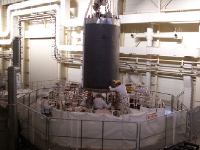A prototype superconductor for Iter coils has performed to design specification in recent tests performed in Naka, Japan; its success is a key technological milestone in the development of Iter.
 |
| The poloid field coil test (Image: JAEA) |
The test coil, with an outer diameter of 1.5 m and weighing 6 tonnes, was manufactured by an international consortium: the Russian domestic agency produced the 0.73 mm diameter niobium-titanium (Nb-Ti) superconducting strands and bundled them into a cable consisting of 1440 strands; the European domestic agency assembled the cable into a steel jacket to make the final conductor. The winding of the conductor, insulation of the turns and the bonding into shape was also performed in Europe. The test coil using the Nb-Ti conductor achieved stable operation at 52 kA and 6.4 Tesla, emulating the operating conditions the PF coils will face in the forthcoming Iter tokamak.
Iter's main aim is to demonstrate prolonged fusion in a deuterium-tritium plasma. The high heat loads in Iter will require enhanced cooling and, for some components, new or modified designs.
Extremely powerful superconducting magnets will be used to maintain the fusion plasma equilibrium and shape inside Iter. Before component designs are finalized, testing at operational conditions is strongly advisable, and demonstrating that the superconducting strands for these magnets would perform to design specification was one of the most important technological milestones for the project.
The partners in the project - the Iter Parties - are China, India, Japan, Russia, South Korea, the USA and the European Union, and the components for the project are being built by each of the partner countries. The EU and France will contribute half of the €12.8 billion ($18.7 billion) total cost, with the other partners putting in 10% each. Japan will provide a lot of the high-tech components, will host a €1 billion ($1.5 billion) materials testing facility and will have the right to host a subsequent demonstration fusion reactor. The total cost of Iter comprises is split evenly between its ten-year construction period and 20 year operational life.
Iter will be constructed in Europe, at Cadarache in the South of France. Work to construct new infrastructure or to modify existing infrastructure, such as widening roads and roundabouts, to allow for the delivery of major components to Cadarache began in January. Over the next 18 months, 90 different engineering operations at work sites in and around the sixteen villages between the port of Berre l'Etang and Cadarache will start. During the Iter construction phase, 200 convoys, on average one every two days, will travel along the route. The nine components of the vacuum vessel will each weigh 600 tonnes and the 18 toroidal field coils, aimed at confining the plasma, will weigh 530 tonnes. The cost of the roadworks to enable the transport of such components will be almost €100 million ($146 million) and will be financed by the Bouches-du-Rhône regional government.




_18570.jpg)
_18938.jpg)
_33584.jpg)
_82983.jpg)





